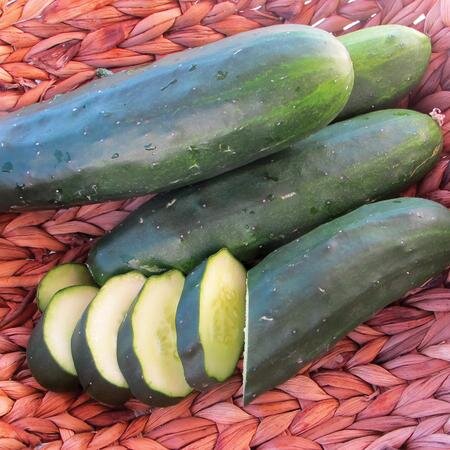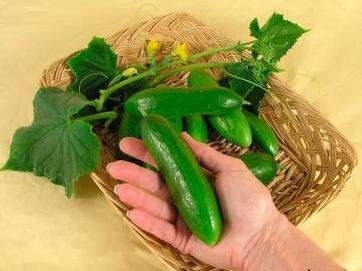Understanding Cucumbers
What’s to understand about cucumbers, you ask? The answer is: Plenty! You can grow pickling, slicing, seedless, and burpless cucumbers. Your plants can have all female flowers, or a mix of male and female. Some varieties do not need to be pollinated to produce fruit. So many choices! We’ll help you to sort out the variables so that you can make an educated decision about which seeds to buy for your home garden.
How Will You Use Your Cukes?
You can use pickling cucumbers for salads and gazpacho as well.
Pickling Cucumbers are small and stout (harvested at 3 to 5 inches), and crisp, with bumpy skins. If you plan to pickle your garden cucumbers, check the seed packet. Some cukes include “pickling” in their name; others will be clearly indentified on the packet.
Slicers are longer cucumbers, perfect for salads. A typical American Slicer, such as the dependable ‘Marketmore 76’ (pictured), should be picked at 6 to 9 inches.
‘Socrates’ is a beit alpha slicer popular with greenhouse growers. It sets predominantly female flowers and does not need pollinators.
Beit Alpha type slicing cucumbers, sometimes called Middle Eastern cucumbers, are dark green in color with smooth, mild tasting skin. These are “burpless” and nearly spineless, and can be picked small or grown to longer lengths.
The very long European-type Slicers (sometimes called English cucumbers) are what you find shrink-wrapped in the grocery stores. These do not typically require pollination, and are grown in greenhouses by commercial growers. They can also be grown successfully in the home garden.
Other Specialty Cucumbers, such as open pollinated Armenian cucumbers, can grow to great lengths, but are best harvested at 12 to 15 inches. Asian slicers (pictured) are spiny and slender and can grow to a foot or more. Heirloom Lemon cucumbers are oval and rarely bitter. Pick them at about 3 inches, when skins are pale yellow and tender.
Snacking Cucumbers (sometimes sold as Baby Persian cucumbers) are ready to eat at about 5 inches in length. Smooth- skinned and tender, they’re the perfect snacking size, and can also be pickled.
Important Tips for Growing Cucumbers
‘Suyo Long’ is an open -pollinated Japanese cucumber that grows to 15 inches in length.
When you plant is important. Wait until the nights are consistently around 50º F (10° C) to start seeds in the garden; too cool and you won’t get successful germination and good growth. It’s wise to cover them with netting to keep birds or other critters from eating the seeds.
You can start seedlings indoors in individual pots. If your growing season is very short or you have problems starting seeds outdoors, cucumber seedlings transplant easily. Sow them no earlier than 3 weeks before you expect to transplant them outside. (Remember that if they are grown too long in the pots, they’ll be so slow to recover from the move that you won’t have saved any time.)
Cucumbers need rich soil and plenty of water. Mulching will hold in soil moisture and keep down weeds. If your cucumbers are bitter, it is probably because they didn’t get consistent watering. Put your finger in the soil –if it is dry beyond the first joint, the plants need water. If the fruits are misshapen, it could be due to nutrient-poor soil or water stress.
In many regions, you can plant cucumbers twice a season. Planted directly in warm soil, these heat lovers grow quickly and begin to ripen fruits in about six weeks!
Terms to Know When Choosing Cucumbers to Grow
Bush and Vining: All cucumbers are vining plants, however, those labeled “bush” are more compact, requiring only 2 to 3 feet per plant rather than 6 feet or more. Trellising will allow you to grow more cucumbers in less space, whether you plant a compact or a more sprawling type. For container growing, choose bush cucumbers. They’ll grow several feet over the edge of the container.
Parthenocarpic* varieties are bred to produce fruit asexually, without the need for pollination. The flowers do not produce pollen and the fruits are seedless, or nearly so, by design. If they are planted outdoors near a variety that does produce pollen, however, they can be pollinated and produce seed. Parthenocarpic cucumbers are preferred for greenhouse growing. Seeds tend to be pricey, as production costs are high.
*Note: Parthenocarpic cucumber varieties are generally gynoecious, though not all gynoecious cucumbers are parthenocarpic.
Left: male flower; Right: female flower
Monoecious and Gynoecious: Cucumbers can be either monoecious (producing male and female flowers on the same plant) or gynoecious (producing all, or mostly all, female flowers). Older varieties of cucumbers are monoecious, with the male flowers appearing first and the female shortly after. Many modern hybrids are bred to produce only female flowers, thus ensuring a lot of fruit over a short period of time. Seed packets of these gynoecious varieties generally contain a few seeds of a standard monoecious variety as well (usually dyed so you can tell them apart). This is necessary so that the flowers will be pollinated and produce fruit.
Burpless: Not everyone experiences burping upon eating cucumbers. For those that do, thin-skinned Asian trellis cucumbers are less prone to cause burping, according to researchers at North Carolina State University. The compound cucurbitacin has been implicated in burping, although there is no compelling evidence that this is true. Breeding has focused on reducing the amount of cucurbitacin in the fruits, as it causes bitterness. Present in all parts of the plant, this compound also acts as a defense against herbivores.
Seedless: Seedless cucumbers are, as a rule, parthenocarpic. If you want to grow cucumbers without seeds in your home garden, be sure to isolate them from pollen-producing varieties, either by ensuring that they are at least ¼ mile away, or excluding insects by growing them under cover.








